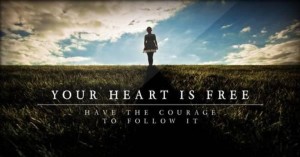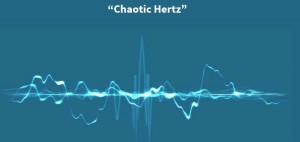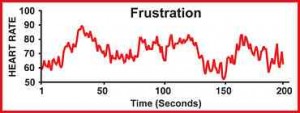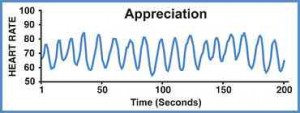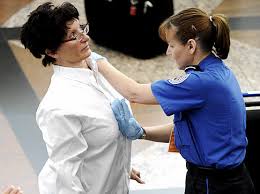Conscious Growth Creation
Have you ever had an experience in your life so challenging that your heart physically hurt? These are the occurrences in life that give rise to the term “heartache” or “broken hearted”. I’ve had a recent experience with this feeling which gives me the opportunity to dive deeper into my own heart and practice the process of using the power in my heart that I talk about all the time.
My heart hurt when I found out that someone I trusted and supported was attempting to blame me and my company for something that occurred in their own life. It was difficult to believe that this was happening because my mission is to continue to help people heal their own heart-hurts by teaching honoring and empowering ways of forgiving and stepping out of the victim role. So I was essentially facing a choice: do I curl up and give up OR do I stand up and keep on going with the mission and vision of Sacred Journey of the Heart?
Well, for me there really is only one choice. As CS Lewis said, “courage, dear heart.”
I discovered that when heartache is happening, there is a frequency disturbance that occurs in the whole body that actually looks like a chaotic, dissonant pattern. This is similar but different than HeartMath’s heart rate variability definition of coherence. HeartMath’s coherence is defined as “an optimal state in which the heart, mind and emotions are all aligned and in synch.” The definition of coherence goes on as: “Physiologically the immune, hormonal and nervous systems function in a state of energetic communication.” In this state, the autonomic nervous system is resonating at a perfect 0.1 Hertz frequency and one’s heart rate variability pattern looks like a smooth wave. I’ve written a lot about this in prior blogs. This is a state of balance that feels really good.
But what happens in our bodies when we encounter a major upset? Every cell of our body can resonate with a “Chaotic hertz” frequency. High levels of chaotic hertz will impact every major organ system and also activate old emotional patterns of destructive cellular memories that Dr. Bruce Lipton talked about in his pioneering book, “The Biology of Belief.”
What I’ve discovered recently, is that during a heartache time, it’s more difficult to get into and stay in this 0.1 hertz frequency of coherence. I’ve experienced this myself and talked about it extensively with my HeartMath and Radical Forgiveness coaching clients. But in perfect timing, I recently came across the work of Dr. Alex Loyd, creator of the Master Key and author of the bestselling book “The Healing Code”. I’ve learned from Dr. Loyd that there is a specific heart-healing frequency that has to do more with the heart itself, vs the heart as it regulates the central nervous system. The specific frequency that Dr. Loyd uses in his technology is 528Hz, which equates to “e” or “mi” on the Gregorian 6 tone musical scale. This is certainly not new information but it came back to my attention at a very important time, just when I needed it!
Here’s an artistic depiction from Dr. Loyd, of what this chaotic hertz might look like:
Courtesy of Dr. Alex Loyd
And here, interestingly enough, is an actual readout from HeartMath’s emWave2 device , which measures physiological heart rate variability:
Pretty interesting connection, isn’t it?
Also, from HeartMath and in from hundreds of my own similar sessions on the emWave2, is the pattern of physiological coherence when we are feeling appreciation and gratitude:
I am so very grateful to have encountered Dr. Loyd’s work, thanks to Doug Parks a wonderful man who is a “people connector”. Doug connected me with Dr. Bruce Lipton who I interviewed in last September’s telesummuit, “The Science and Art of Opening Your Heart”. And thanks to Doug again, I’ve connected with Dr. Loyd who will be one of my special guests for the next telesummit, “The Science and Art of Healing Your Heart.” Dr. Loyd has graciously agreed to share his latest discoveries on heart healing and the frequency of Love, or 528 Hertz as part of June telesummit. (See below for more information about my guests and the broadcast dates!)
I have been a long-time fan of binaural tone technology and in fact, I’m listening to the Monroe Institute audio as write this article. The Monroe Institute pioneered the field of binarul beat research and created “Hemi-Synch”, a wonderful technology for regulating the body. Dr. Loyd, in my opinion, takes this technology even further as he incorporates the 528 Hertz musical tone into his audios and videos for amazing heart-healing. I’ve been using his system for just two weeks, and while I still experience some intense emotions about what I’ve experienced, I can say the my heart is no longer hurting. I attribute this to incorporating the Heart- Hertz frequency into my other daily practices of my own Heart Shift meditation*, using my HeartMath emWave and doing lots of radical forgiveness worksheets!
*My new gift to you will be online soon: a 20 minute guided meditation to shift your heart from guarded and defended, to open and free!
So I invite you all to share your own heart-healing experiences and to set the stage for the upcoming telesummit, The Science and Art of Healing Your Heart.
(Note for my non-US readers- TSA is the Transportation Security Administration, the group in charge of airport security in the US)
Airports and stress have come to by nearly synonymous since 9-11. The 9-11 incident changed our lives in many ways as a society, none more evident than our experience of traveling through the “friendly skies”. I travel extensively as part of sharing my film with the public and coaching with individual clients. While on the road, I am always asked by at least one person : “How can you stand to fly so much? Isn’t it just terrible at the airports today?” My answer is, “I love traveling and one of my favorite things to do is to lighten up a TSA agents’ day!”
But I had to consciously work on this, on many levels, especially when they started the “pat down search”. Here is a photo of how I felt before I hit upon an effective de-stress practice at the airport.
Would you rather be right or be happy, is a well-known lesson in A Course in Miracles. My Valentines version of this is: Would you rather wait for the “right way” to express love or, be ecstatic for all the ways and opportunities to give and receive more love and appreciation? In this article, I share with you six steps to turn a “Heart-Scrooge” into a “Heart-Sharer”.
 What is a Heart-Scrooge? Obviously, borrowing from the Dickens character in A Christmas Carol, a Heart-Scrooge is a person who is miserly in the expression of love and appreciation, and by reciprocity, reluctant, unwilling or unable to receive it from others. Just like Scrooge in the Dickens novel, a Heart-Scrooge would say “Valentine’s Schmalentines” to Valentine’s Day and carry on like it was nothing special to celebrate.
What is a Heart-Scrooge? Obviously, borrowing from the Dickens character in A Christmas Carol, a Heart-Scrooge is a person who is miserly in the expression of love and appreciation, and by reciprocity, reluctant, unwilling or unable to receive it from others. Just like Scrooge in the Dickens novel, a Heart-Scrooge would say “Valentine’s Schmalentines” to Valentine’s Day and carry on like it was nothing special to celebrate.
I have to admit that I used to be a bit of a “Heart-Scrooge”. Before “Sacred Journey of the Heart”, I was someone who would go around saying things like “Valentine’s Day is just a made-up Hallmark card holiday,” or “I don’t need a special day to remember to say “I love you”, (and all the while, not loving myself very much and being somewhat stingy in expressing love and appreciation to others!). Not only was I stingy with my feelings, much like Scrooge was with money, but I also used to be afraid to express them, just in case I’d make a fool of myself or I’d get hurt.
I now call this my former “Heart-Scrooge” period. In fact, you can see how it looks to be an actual “Heart-Scrooge” in the first two minutes of the film, in my “before” pictures. (Click here to view the prologue to the film… ) – I look scared, withdrawn, serious (very serious) and kind of boring as a person. AND you can see what it looks like “after”, when I became a Heart-Sharer.
Heart-Scrooges most likely say “bah-humbug” about roses and cards and candy. As a recovered Heart-Scrooge, what I call a “Heart-Sharer”, I now love the holiday! I look forward to it and plan on expressing and sharing in many ways! And it’s a fantastic reminder of how we may choose to love every day, if we just give ourselves permission to say, “Thank you, I love you, I’m glad you’re in my life”.
I found out too, as I was recovering my full ability to live as a 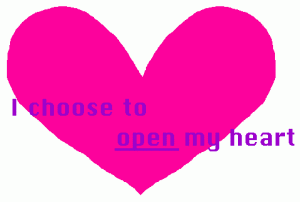 “Heart-Sharer”, that lots of people are walking around in a heart-scrooged-up manner. Meaning, they know that they are capable of loving, and sharing way more than they are right now. If you harbor this secret desire inside to share more from your heart, then know that there is a pathway to change!
“Heart-Sharer”, that lots of people are walking around in a heart-scrooged-up manner. Meaning, they know that they are capable of loving, and sharing way more than they are right now. If you harbor this secret desire inside to share more from your heart, then know that there is a pathway to change!
As we all know, change occurs first with yourself. So the following steps are 6 steps aimed at helping you shift any last vestiges of your inner Heart-Scrooge to a Heart-Sharer:
6 Steps to Transform from a Heart-Scrooge to a Heart-Sharer:
- First, you have to admit two things: a) you’ve been miserly with your feelings as if sharing them would “cost” you something, b) you’re afraid you might get hurt. Without facing these two things, you gloss over the surface and set up defense patterns and barriers to the deepest part of your heart, thereby lessening the amount of love you give and receive. It’s a simple formula: Fear x denial = Shut down. Try this one instead: Fear x acknowledgement = Openness to change.
- Second, you have to “take the garbage out of your heart”. Plain and simple. You can’t shift from a Scrooge to a Sharer if you are not willing to admit that you picked up one or both of these core negative beliefs somewhere along the line: a) “love is scarce” and/or b) “I don’t deserve love”. You must face these beliefs and recognize them for what they are: FALSE. But you can’t change these beliefs until you love them! That’s the surprising part. You cannot change a negative belief by acting “negative” towards it! Saying “I want to get rid of this BAD belief”, doesn’t work. Try this instead. Look into your own eyes and say: “I recognize that I have held these beliefs until now, and I lovingly release them. I now believe, with all my heart, that Love is infinite and I am worthy of all that love has to offer”. The Rx for recovering from heart-scrooginess is to repeat this at least 20 times a day, no less! (Note: I give credit to this powerful process to Colin Tipping and the transformative process of Radical Forgiveness. As Colin says, “the only thing that transforms an old belief is to love first!”)
- Third, become Engaged to yourself! One of the experts in my film, Sarah McLean, shared this concept with me in last September’s telesummit interview for “The Science and Art of Opening Your Heart”. After years of being single, Sarah
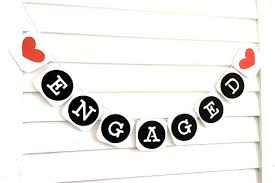 decided to treat herself as she wanted to be treated by that “someone special”. She gave herself compliments, took herself on long walks on the beach, bought herself flowers, went out to dinner at nice places and even purchased an engagement ring for herself. She stopped looking outside for love and fell in love within. It was during this time, when she wasn’t looking for it, that her soul mate found her and true love blossomed in her life. This step is life-changing. To be engaged with love, engage yourself within, with loving feelings, words and actions. (Sarah’s interview and transcript are available as part of our Heart Specials Month. Click here for more information about how to obtain Sarah’s full interview.)
decided to treat herself as she wanted to be treated by that “someone special”. She gave herself compliments, took herself on long walks on the beach, bought herself flowers, went out to dinner at nice places and even purchased an engagement ring for herself. She stopped looking outside for love and fell in love within. It was during this time, when she wasn’t looking for it, that her soul mate found her and true love blossomed in her life. This step is life-changing. To be engaged with love, engage yourself within, with loving feelings, words and actions. (Sarah’s interview and transcript are available as part of our Heart Specials Month. Click here for more information about how to obtain Sarah’s full interview.) - Fourth, you must be willing to be vulnerable. To become a Heart-Sharer, you must be willing to express not suppress! This means you have to take risks, sometimes purposefully play the fool and at all times, remember that becoming a Heart-Sharer is the greatest gift you can give to yourself and others! You have to be willing to open your heart and allow two things to happen: a) your feelings to come out and b) other’s feelings to “come in”, meaning for you to become aware of other’s feelings about you. Here’s another formula: Feelings ÷ suppression = Heart contraction (or heart attack). Try this instead: Feelings x expression = Heart expansion.
- Fifth, go for it! Make a promise to yourself that, “On this day, I will not let any opportunities to express love go by the wayside.” Promise yourself that you will not be someone who experiences one of top 5 regrets of the dying! (Regret #3 is: “I wish I’d had the courage to express my feelings”.) Go for it! Even if it’s hard, do not wait! Say what you desire and need to say. Sometimes it’s awkward but you will not have to live with this painful regret. If you need to, be willing to say: “I’m sorry I haven’t called in so long. I didn’t know how to reach out, but I’m doing it now. I miss you.”
- Sixth, get creative! Take advantage of any and all ordinary and special opportunities to Love – Valentine’s Day, Birthday’s holidays and any other reason to share. Why miss a single one? If you’re a recovering Heart-Scrooge, make a promise to yourself for the rest of 2014, you will have a Secret Valentine’s Day every 14th of the month. Without telling others, make the 14th your special day to express love and appreciation by surprising people with “secret heart-sharer” presents, sort of like “Secret Santa”. Leave a small note of appreciation on a friend’s desk at work or send a text, leave a message or put a small token of affection on your loved one’s pillow.
What I discovered through my own Heart-Scrooge to Heart-Sharer transformation, was that it was far more 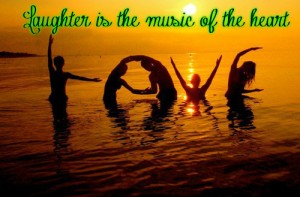 painful to live all “Scrooged-up” in my heart-space than the temporary discomfort I experienced in learning to open my heart and share. In the final lines of A Christmas Carol, Dickens wrote this about Scrooge’s transformation: His own heart laughed: and that was quite enough for him…. May that be truly said of us, and all of us!” Happy Valentine’s Day to all of us!
painful to live all “Scrooged-up” in my heart-space than the temporary discomfort I experienced in learning to open my heart and share. In the final lines of A Christmas Carol, Dickens wrote this about Scrooge’s transformation: His own heart laughed: and that was quite enough for him…. May that be truly said of us, and all of us!” Happy Valentine’s Day to all of us!
 “The new frontier of human evolution is one that connects us, not just as a catch phrase, but in a deep and meaningful way,” says Ronna Prince in her documentary film, Sacred Journey of the Heart. What does this mean? “When we live in this interconnected way,we not only know it in our minds, we feel it in our hearts and in every aspect of our lives, in our relationships with each other and in every step we take on our journey to wholeness and love.” Ronna’s film presents the science and spirit of our connection and focuses on our hearts’ innate power to connect us, not only to each other, but to earth itself.
“The new frontier of human evolution is one that connects us, not just as a catch phrase, but in a deep and meaningful way,” says Ronna Prince in her documentary film, Sacred Journey of the Heart. What does this mean? “When we live in this interconnected way,we not only know it in our minds, we feel it in our hearts and in every aspect of our lives, in our relationships with each other and in every step we take on our journey to wholeness and love.” Ronna’s film presents the science and spirit of our connection and focuses on our hearts’ innate power to connect us, not only to each other, but to earth itself.
Here are Ronna’s 9 easy practices to change your life.
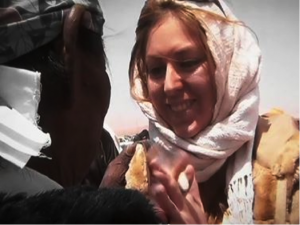
I see you
# 1) Making a heart-based connection with people around you is easier than you think! You can make a heart-connection to anyone at all in this simple way: look into a person’s eyes and silently say: “I see you.” That’s it, no words necessary. Try it and you will notice how this opens your heart to others. And often the person you are silently noticing will open up to you in a genuine way: with a true smile, a heart-felt “have a nice day” or even to a more meaningful conversation. Establishing a simple visual connection with another person can be the beginning of cultivating a more heart-centered life.
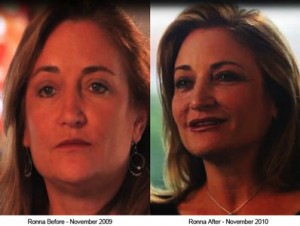
Self-Acceptance, A Deeper Peace
# 2) When you live in your head, or in the world of ideas and analysis, there is a tendency to ignore feelings and shut down your heart. In making the film, Ronna discovered that she was living mostly in her mind and ignoring her heart. One of the easiest ways to reconnect to one’s heart, says Ronna, is to try this simple practice: Look into the mirror and say to yourself, “I accept myself.” In doing this, you will learn exactly how you feel about yourself. You’ll instantly hear your inner dialog, and from there you can begin to give yourself new messages based on connecting to your heart. The rewards of being lovingly connected to yourself are many, including more energy, deeper peace, and an inner beauty that emerges for all to see.

Practicing Curiosity
# 3) When dealing something difficult or unexpected, we have a tendency to think about the possible outcomes in the future. We project, analyze and often, worry. If we remember that there is usually a deeper meaning in challenges, a silver lining in the clouds, so to speak, we can practice this heart-based action: close your eyes and ask yourself: “I wonder where my heart is leading me?” Adopting an attitude of curiosity opens our hearts to a wider perspective. This simple question can help us stay calm rather than forever being buffeted by the external winds of change.
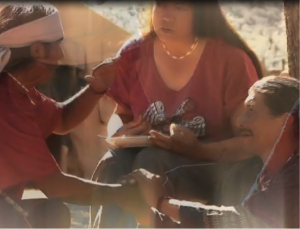
The Art of Expressing Feelings
# 4) Expressing your feelings effectively is at the core of heart-based living. If you’re not comfortable with feelings in the flow of everyday interactions, try this simple practice: ask a person you are comfortable with, a friend or partner, to sit with you as you practice simple feelings-based phrases like: “I feel lonely. I feel content. I feel sad.” In response, your partner simply reflects this back to you by saying, “I feel your loneliness, I feel your contentedness, I feel your sadness, and it’s OK” – even if he or she doesn’t feel it. This is very powerful and will bring forth a lot of emotion, so do it with someone you trust.

Knowing what matters most
#5) If you live from your heart, you absolutely know what matters most to you at a core level. Heart-based living is about conscious choice in alignment with your values. It means that when change happens, as it always does, you are not left reacting to it. Rather, you draw upon a deep well of inner knowing. If you haven’t written down what matters most to you, set aside an hour to do this. Then review it every morning and you will notice a profound change in how you go about your day.
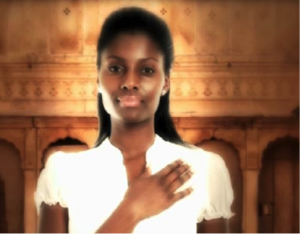
Choosing Peace
#6) As viewers learn in the film, Sacred Journey of the Heart, your heart sends out a specific emotion-based encoding that is broadcast heartbeat-to-heartbeat into the field around you. When you are stressed, frustrated or complaining, the signal broadcast from your heart looks like a jagged line. When you are in a state of inner peace and appreciation, your heart is broadcasting a smooth, coherent signal. Try this simple practice when you are feeling upset or riled up by something or someone: Take a deep breath, focus on your heart and silently say to yourself: “I choose peace.” Doing this diffuses your reactivity and brings you into connection with your heart. As shown in the film, your heart’s signal can actually influence those around you to react more peacefully.

Cultivating Joy
# 7) Living a heart-based life means consciously choosing to experience joy. Joy is defined as “an emotion of keen pleasure or delight.” Joy can be a fleeting feeling based on something wonderful happening “out there.” Or joy can be cultivated by taking time to connect with nature, with animals and, of course, with the people in our lives. Joy is an emotion that regenerates us and fills our cups so that when challenges arise, we know exactly what we can do to enjoy a moment of respite from the storm. Having a “joy-list” is an essential part of heart-based living. Take a few moments to write down your “joy-list” and then create a joyful experience every day.

Expressing Gratitude
# 8) Heart-based living also entails the practice of expressing gratitude. Gratitude is a choice that becomes a lifestyle when practiced daily. Find something to be grateful for every day and take a moment to savor it. This is a key element to being in the connection to our authentic self and the world around us. The feeling of gratitude can be generated without an external stimulus. Just remember a time you felt truly connected to nature or to a person and you will know, without doubt, it was a heart-based connection. A simple practice to cultivate gratitude is to put a gratitude journal by your bedside and commit to writing at least 10 things that you are grateful for at the end of each day. This is also an easy way to set the stage for a great night’s sleep!
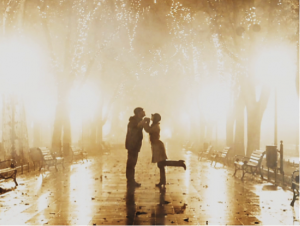
Celebrating Love
# 9) Love is the greatest gift in life. Celebrating love takes many forms: a hug, a smile, a card on a special occasion or a gift given for no reason at all. Ronna notes that people who take time to celebrate the love they already have, usually end up attracting more! “This is beyond the popular ‘law of attraction’ principle that so many people are now familiar with,” says Ronna. “To me, it’s a higher law that I call the ‘Law of Confluence’ that is presented in the film.” Attraction is based on duality, like-attracting-like. Confluence is a weaving together of multiple streams of interaction. Confluence creates a wide-open field of possibility, compared to the limitation implied in attraction. Celebrating love is a key part of confluence. When we come from a place of love and the reality of our interconnection, we create a new world of heart-based living.

Leading the Heart Journey
To see an illuminating and heart-inspiring trailer, featuring such leaders as Greg Braden, Dr. Joe Dispenza, Mary Morrissey, Colin Tipping, Sarah McLean, plus Dr. Rollin McCraty and Dr. Deborah Rozman of HeartMath –along with Ronna’s powerful story—click here!
“I don’t take sides”.
That’s what I thought too! I aim to stay neutral and calm, to first gather the facts and after that, respond in a wise and measured way. But then a reality check came in yesterday to test me when my son, in his “new-used car” went careening off the crowded 101 freeway in Phoenix, Arizona and slid down an embankment in 8 lanes of speeding traffic. The good news is that no one was hurt. Even more miraculously, not a single car was scratched or dented. The “interesting” news was how I reacted, as you’ll see below.
The topic I am tackling this week is identification and anger. Admittedly, it’s a topic we don’t deal with often but it the emotion will come up at times to provide us with lots of information about who we identified with in our formative years and how we learned to express this important human emotion. In fact, I thought I had figured this one out! I even went so far as to express anger on-screen in chapter 2 of my film, Sacred Journey of the Heart. As I always say though, with insight comes opportunity to change.
After reflecting on my initial reaction to my son’s “near-miss”, I have to say I was surprised that a part of me had been identifying with my passive-aggressive, chronically angry father. But I’ll discuss my personal experience later on in the article.
Anger: A Normal Human Emotion
Anger is a normal emotion that is naturally displayed in infants around 6 to 9 months of age. In healthy situations, it simply indicates one of two things: 1) “I’m not getting what I want” or 2) “my personal space (in psycho-babble talk a “boundary”) is being crossed and I’m upset”. The interesting aspect of this topic comes in when we look into the roots of learned-behavior and examine the type of anger-examples and anger-messages we experienced in growing up.
Healthy vs Unhealthy Anger
Very few of us were raised with healthy anger examples. An example of a child seeing a healthy adult expression of anger would be this: 1) Adult A is angry about something and says “I am angry because you did (or did not do) x!” 2) Adult B would say, “I hear you.” And then the two adults would proceed to discuss what happened and what to do about it to resolve the situation. Often, all that is required is a simple, sincere apology. (And by the way, this is how my significant other and I handle anger! It’s not just a hypothetical.)
The reality we experienced as children is more like this: Adult A flies off the handle and accuses Adult B of something. Adult B becomes instantly defensive. A screaming match ensues wherein one of the two Adults emerges as powerful and victorious. OR both leave the scene still simmering with anger over the unresolved situation. Sound familiar?
Another variation is that one adult in the household is chronically angry but doesn’t express it outwardly. The rest of the family tiptoes around and waits for a passive-aggressive display of anger – like slamming doors, muttering to him or herself, cursing at the TV program, and talking about how everyone else is an idiot and moron… and generally making everyone else uncomfortable due to the underlying expressed emotion.
Identification
The fact is that growing up in any of these environments teaches children what is acceptable about the expression of anger. The question I am posing is this: if you grew up in an unhealthy anger environment, which “side” of the anger equation did you identify with most often? If you have this insight, you can then watch and commit to consciously ferreting out the vestiges of anger-identification. For most of us at this stage of the game, it’s subtle, like it was in my case. But unexamined, it can lead to underlying stress and relationship discord as well as a more pervasive world-view that will be reflected back to you in the form of frustration, anxiety and doubt.
I will be talking tonight at 5 pm Central Standard Time about a technique I use to shift old-learned behaviors. It’s based on my program called “Spirit-Heart-Intelligence-Feeling-Technique”. (Learn more by clicking here.)
What children learn about anger
As children, most of us typically learned that if we expressed anger outwardly we would be punished. So we learned to suppress this natural emotion and we continued to observe how adults dealt with it. Without knowing it, we took sides with one of the parties involved in the emotional interchange. In my counseling and coaching practice, I’ve seen men and women who have an “angry” personality – they have a chip on their shoulder and feel that they’ve unfairly been dealt a bad set of cards. Some of them don’t even know they are projecting this anger. When I encounter repressed anger, it feels like I’m face to face with a cornered cat that has arched its back and is snarling with its claws out. These people wonder why they have difficulty making friends, staying in intimate relationships and in some cases, making babies cry when they come in the room. (I’ve seen it happen!)
The Anger Equation
After delving into the anger equation, my clients have experienced growing up, we often find out the they’ve taken on an identification with either the angry parent (aggressor) or the silent-suffering parent (victim). It really boils down to two entangled beliefs: “It’s all your fault” or “It’s all my fault”. These beliefs play hand-in-glove and complete the dysfunctional anger equation. And it’s surprising how easily we revert to the identification of one or the other roles in times of stress. Ultimately, we are not really tested until we experience a real-life situation that calls this old pattern up onto the real-life screen of our lives.
My blame-game anger reaction
In relation to the event with my son yesterday, I learned that a small part of me was still acting on learned behavior from my father’s passive-aggressive anger that would explode into accusations without facts. He would blame people without information and burn his bridges leaving a number of wounded behind. As a child, he looked like the powerful one- he was right, everyone else was wrong.
How that played out for me yesterday was this: after going through a myriad of emotions in about one minute after my son’s phone call, I landed on anger and found myself wanting to react. I jumped to a number of conclusions, none of which were correct. I found myself ready to call the used car dealer and launch accusations and a few choice words about their selling dangerous, mechanically deficient cars to young adults. Next I wanted to call my ex-husband to blame him for failing to take the used car to an independent inspector to check it out before completing the sale with our son. My anger was raging about as I was searching to cast blame on everyone I could identify as having been responsible for my son’s near-disastrous experience. I even blamed the other drivers on the road because not one of them stopped to see if he was OK. Mind you, I didn’t have any facts at this point.
The Choice to SHIFT
But through the phone line my son said: “Mom, chill out, I’m OK”. Then all my training and personal commitment kicked back in and I chose to SHIFT out of this state of reactivity. After all, I know how anger looks on an emWave readout:
<Image>
I went through my practice and got into coherence. At this point, my primary emotion shifted to gratitude and I stopped reacting without facts.
After all the facts are in, the car has been inspected and I had a calm discussion with my son, it turns out that the brakes are fine. The primary contributing factor was a 20 year old, my son, driving too fast and too close on a crowded interstate highway. Lesson learned, all the way around.
The SHIFT foundation
As I listened to my son play guitar that evening, I immersed myself in one of the deepest feelings of gratitude and contentment I have ever felt. His music is one of the most beautiful sounds on earth to me. The opportunity to examine and SHIFT an old anger identification was just the tip of iceberg. The foundation, what lies beneath, is love and appreciation. I almost lost my son exactly 20 years ago when I was pregnant with him. I slipped and fell on the ice at 6 months gestation and went into pre-term labor. I defied all the doctors’ predictions and went on to give birth to him at full term. I realize that Spirit is at the core of this and every other life-changing moment, which is why I always begin my conscious-change creation process with an acknowledgement of the Spirit in all things, the perfection in experience, and gratitude for the big and small things in life.
The commitment you Must make to create lasting change.
This time of year we hear all about New Year’s resolutions and how to keep them. I‘ve created resolutions and then fallen off track within the first few weeks of January. However, in making the film Sacred Journey of the Heart, I believe I’ve discovered the KEY to lasting change. And it’s not just about the heart!
So what is the key? It’s the awareness of the thought and feeling patterns that keep you stuck and disempowered. Of my list of 10 patterns below, the most important one to be aware of in relation to change, is what I call “The Motivation Zapper”. If you are truly interested in lasting transformation, I contend that no old habit can be changed and no new one implemented without ferreting out the vestiges of these learned “victim-thought-feeling” patterns. I suggest that you make ONE commitment for 2014 – to notice these patterns and to kick them to the curb! The rest of your “resolutions” will follow easily from here!
The key commitment to change
Resistance to change is very simply a vestige of learned victim habit patterns. Most of us think we don’t have these anymore but if you’ve ever found yourself wondering “how did I end up here again?”, then it’s likely that lurking in the shadows is a remnant or two of your old familiar victim self. “But I’m not a victim anymore!” I’ve said this and I’ve heard others say it, but then… look at your results. If you are not where you want to be, how about making a choice to commit to a new way of anchoring in New Year’s resolutions?
The most important commitment you can make is to be aware of the 10 patterns below and to shift them as soon as you notice them:
Change-Blocking Thought & Feeling patterns
- The motivation zapper: “I can’t because” – Powerlessness
- The procrastination syndrome: “I’ll do it later” – Resistance
- The paralyzing excuse ploy: “If only x than y” – Helplessness
- The self-styled straight-jacket: “I can’t decide” – Doubt & Indecision
- The stupefying safety zone: “I can’t figure it out” – Confusion
- The chronic apology: “I’m sorry, it’s all my fault” – Guilt
- The reverse road-block: “If only I had…” – Regret
- The anti-enthusiasm energy drain: “What if….” Worry
- The blame game: “It’s all your fault” – Resentment
- The emotional bypass: “It’s all good” or “I don’t have that problem” – Denial
The origin of the pattern
At the root of every “bad habit” or something we want to change about ourselves is a remnant of a learned behavior based on a specific thinking-feeling pattern. As a mother of 4 children, I know that we come into this world believing in limitless possibilities. Little kids believe they can do anything- fly, win every game they play, and be anything they want to be. The #1 cause of “victim-think” process is not yet instilled in them.
Over time, kids learn that they can’t do x,y,or z because of something outside of their control. Most of this is rational but a good portion is the limited paradigm that we are all subject to as we grow up. Very few of us learn the paradigm-altering reality of quantum field energetics. You know, the “observer’s expectations alter the behavior of the object”? So we learn to become limited, safe and less-than-the powerful beings we truly are.
The most common roadblock to change
Of my list of 10 patterns below, the most important one to be aware of in relation to change, is what I call “The Motivation Zapper”. This is any statement that begins with, “I can’t because….”. Language is very powerful and plays a major part in shaping our reality. When you say or think this #1 disempowering phrase, you are actually saying “I can’t Be the Cause in my own life for change.”
Whenever we feel disempowered it can bring us back to a state from our childhood when we didn’t have the ability to make choices about what we wanted to do and when we could do it. We often didn’t have choices about simple things that today we take for granted, such as when to go to bed and when to wake up, what to eat, what to wear and who we had to hug and kiss. Does anyone remember being told as a child “Go kiss your Aunt?” And the aunt had bad breath or slobbery kisses? Even when we’ve been on the path of consciousness for a long time, the chemical memories of powerlessness can sneak up on us and take us right back to this state without even noticing it.
If you commit to noticing how you use the phrase “I can’t because…” , you may discover that this Motivation Zapper is impacting small decisions as well as big ones. Noticing is the first step to change. From here, you can take the next two steps to make change permanent.
The 3 steps to shift old patterns:
1) Notice – becoming aware
2) Choose – taking action
3) Shift – anchoring the new pattern
Shift Teleclass:
S-H-I-F-T is my own proprietary process I teach in private sessions and workshops and it stands for “Spirit-Heart-Intelligence Foundational Technique”. It’s a simple integrative spirit-emotion-thought based process that gets at the root of resistance and anchors in permanent change.
On Wednesday, January 15 at 5 pm central standard time, I will be offering a 90 minute tele-class on how to shift each one of these 10 patterns. If you want to shift anything, you first have to know where you are on the MAP and where you want to go. The M-A-P is part of shift process I’ll be sharing on the call. The investment in this 90 minute class is only $14.99. Stay tuned on January 6th for information about how to register for this class or email me now for early bird registration at only $9.99! Yes! send me info on Early bird registration
As a preview, here’s what we shift to on our internal MAP:
OLD PATTERN NEW PATTERN
- Powerlessness Empowered
- Resistance Willingness
- Helplessness Resourceful
- Doubt Certainty
- Confusion Assuredness
- Guilt Appropriate Responsibility
- Regret Contentment
- Worry Peace
- Resentment Acceptance
- Denial Acknowledgement
I will be discussing these patterns throughout 2014 on my blog so you can stay tuned over time or join me for the SHIFT process on January 15. If you can’t make the call “live” you can listen to the recording at your convenience. When you sign up, you will receive the dial-in number and PIN.
I look forward to an empowering and life-changing 2014!
Happy New Year!
Ronna
Welcome to WordPress. This is your first post. Edit or delete it, then start blogging!

